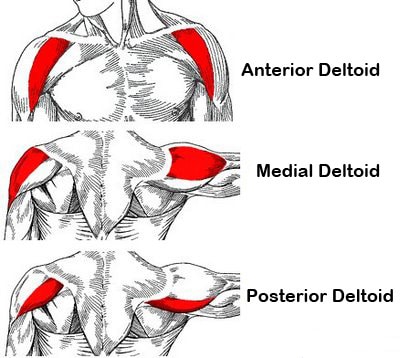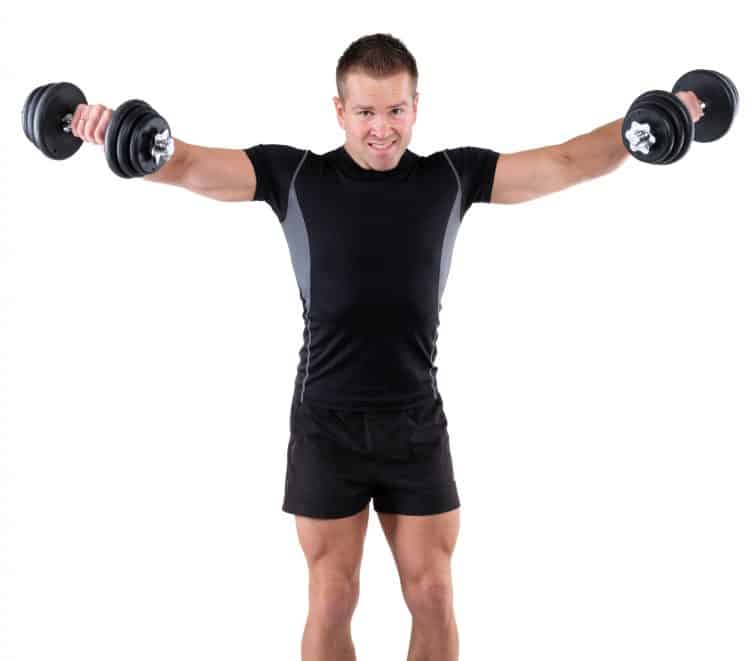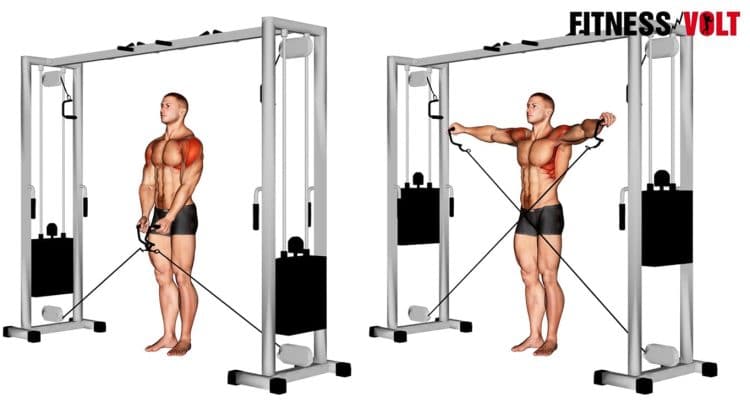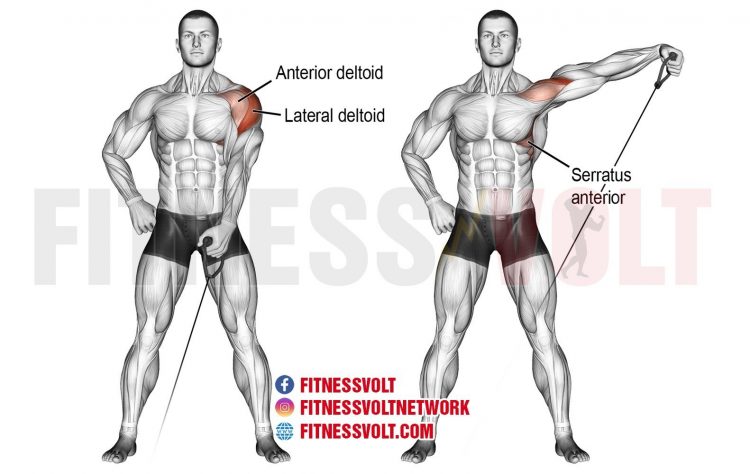Your shoulders are probably your most visible body part. Whether you are fully dressed or wearing a workout vest, well-developed shoulders are always on show. After all, it’s your shoulders that give your upper body its width and contribute so much to that all-important V-taper.
However, you’ll need to do more than overhead presses to build the shoulders of your dreams. That’s because there are three major muscles that make up your shoulders, and each one has a different function.
Of the three, the medial or middle deltoid is responsible for the width of your shoulders. In this article, we reveal how the medial deltoid works and the fourteen best exercises for increasing its size.
- Deltoid Anatomy
-
The 14 Best Middle Delt Exercises
- 1. Standing dumbbell lateral raise
- 2. Seated dumbbell lateral raise
- 3. Cable lateral raise
- 4. One-arm cable lateral raise
- 5. Dumbbell L-raise
- 6. Lean-away dumbbell lateral raise
- 7. Side-lying lateral raise
- 8. Power lateral raise
- 9. Doorway isometric lateral raise
- 10. Sliding lateral raise on wall
- 11. Wide-grip barbell upright row
- 12. Dumbbell monkey row
- 13. Iron cross walk
- 14. Victory dumbbell/resistance band raise
- Middle Deltoid Workout
- Middle Delt Exercises – Wrapping Up
Deltoid Anatomy
Your shoulders are made up of three main deltoid muscles or heads, which are often just called the delts for short. The three deltoid heads are:

- Front/anterior deltoids – located on the front of your shoulder and responsible mainly for flexion of your upper arm, the anterior delts are involved in all overhead pressing and chest exercises, as well as front raises.
- Rear/posterior deltoids – the posterior delts are located on the back of your shoulder and are responsible for extension and horizontal extension of your upper arm. They’re also an essential muscle for better posture. The posterior delts are involved in most back exercises and can be trained more directly with exercises like reverse flyes, band pull-aparts, and face pulls.
- Medial/lateral deltoids – also known as the middle delts, this deltoid head is located on the side of your shoulder and is mainly responsible for your shoulder width. Its main function is the abduction of your upper arm, which means lifting it up and out to the side.
While the three deltoids usually work together, it’s possible to target and emphasize each head with specific movements. In this article, we’re going to reveal 13 exercises for the middle delts.
The 14 Best Middle Delt Exercises
Build your middle delts with these fourteen tried and tested exercises!
1. Standing dumbbell lateral raise

If you want to target your middle delts, this classic exercise is an excellent place to start. Simple but effective, this move is guaranteed to add size to your side delts. No dumbbells? No problem! You can do this exercise with individual weight plates, water bottles, or even cans of food.
Learn how to do this exercise here.
2. Seated dumbbell lateral raise

If standing dumbbell lateral raises have a disadvantage, it is that it’s all too easy to use your back and legs to lift the weight. As the saying goes, cheats never prosper, and if you find yourself swinging rather than lifting the weights up, you may not get all the benefits that this exercise has to offer. Seated dumbbell lateral raises are much more cheat-proof and also take some of the pressure off your lower back.
Check out our guide to find out how to do this exercise.
3. Cable lateral raise

Cable lateral raises keep your delts under constant tension, which is good for muscle growth. With no “dead spots” in the movement, you won’t be able to take any sneaky mid-rep rests, and you’ll probably get a better pump too. However, you will need a cable crossover machine to do this exercise.
Read more about this exercise here.
4. One-arm cable lateral raise

Training one arm at a time means you can really focus on your mind-muscle connection to get better results from your delt-widening workout. As an added advantage, unilateral (one-sided) exercises like one-arm cable lateral raises allow you to identify and fix left to right strength imbalances. Plus, you only need to use a single low pulley machine for this exercise, which will save you from hogging the cable crossover machine all to yourself!
Discover how to do this effective middle delt exercise in this article.
5. Dumbbell L-raise
Dumbbell L-raises are done with your arms bent to 90-degrees. This shortens the lever so you can lift more weight, for less joint stress, and also increases posterior deltoid activation. Still, it provides you with a useful alternative you can use to keep your middle deltoid workouts fresh, interesting, and effective.
How to do it:
- Hold a dumbbell in each hand. Bend your elbows to 90-degrees. Pull your shoulders down and back and brace your abs.
- Without changing the angle of your elbows, raise your upper arms until they are parallel to the floor.
- Lower your arms back to your sides and repeat.
6. Lean-away dumbbell lateral raise
This lateral raise variation takes some of the work away from the start of each rep and increases muscle tension as your arm reaches parallel. It’s another helpful variation you can use to add some extra variety to your middle delt workout.
How to do it:
- Hold a dumbbell in one hand and grasp a pole, rail, squat rack, or cable machine with the other.
- Lean out to the side and let the dumbbell hang down toward the floor. Your palm should be facing your leg, and your elbow slightly bent but rigid.
- Raise the dumbbell up and out to shoulder height. Keep your body stationary.
- Lower the dumbbell back down and repeat.
- Do the same number of reps on each arm.
7. Side-lying lateral raise
Where lean-away lateral raises increase the overload at the top of each rep, side-lying lateral raises increase the overload at the start.
As well as working your middle delts, this exercise also emphasizes your supraspinatus, which is the rotator cuff muscle responsible for initiating abduction.
How to do it:
- Set the backrest on an adjustable bench to 30-45 degrees. Sit sideways on your bench, and then lean your upper body against the backrest. Hold a dumbbell in your free hand.
- Keeping your elbow slightly bent but rigid, raise your arm up until it’s perpendicular to your body.
- Lower the dumbbell back down and repeat.
- Do the same number of reps on each side.
8. Power lateral raise
We said earlier that cheats never prosper, but that’s not always true. Sometimes, a little cheating can help you reach your goals faster. The power lateral raise involves some strategic use of your legs and lower back so you can use heavier weights.
This creates a LOT of muscle tension, which may trigger increased growth. Unlike lighter weight, higher rep middle delt exercises, this move will increase muscle strength and power, and not just size.
How to do it:
- Hold a dumbbell in each hand in front of your thighs. Your elbows should be slightly bent but rigid.
- Lean forward slightly and bend your knees.
- Stand up and use this momentum to help you lift the weights up and out to the side. Don’t worry if you can’t lift the dumbbells all the way up to shoulder height; just lift them as high as you can.
- Lower the weights under control and repeat.
9. Doorway isometric lateral raise
The best middle delt exercises involve a large range of motion. However, you can also build and strengthen your muscles isometrically or statically. This is a useful exercise if you have no training equipment available but still want to pump up your middle delts.
How to do it:
- Stand in a doorway. With your arms slightly bent but rigid, place the backs of your hands and forearms against the inside of the doorframe.
- Without holding your breath, push your arms out against the doorframe as hard as you can and as long as you can.
- Relax for a moment and then repeat.
10. Sliding lateral raise on wall
This is another useful exercise for those times when you want to work your middle delts but don’t have access to any training equipment. For this move, all you need is a wall.
How to do it:
- Stand sideways onto a smooth wall, with your arm bent to 90-degrees. Place your forearm against the wall.
- Abduct your upper arm just like you were doing a single-arm side raise. Push your body away from the wall and slide your forearm up.
- Return to the starting position and repeat.
- You can also do this movement minus the slide, which could be useful if you only have a rough wall to train against.
11. Wide-grip barbell upright row
Upright rows don’t look much like lateral raises, but, in actuality, the movement is very similar. As you row the barbell up the front of your body, your upper arms abduct and move away from the midline of your body, which is a movement powered by your medial deltoids.
Upright rows are a slightly controversial exercise because they can be hard on your shoulder joints. However, wide-grip upright rows are often better tolerated than the narrow grip version. As an added benefit, upright rows are also a GREAT upper traps exercise. You can also do this exercise using a cable machine.
12. Dumbbell monkey row

While this exercise looks kinda funny, it’s actually a very effective middle deltoid exercise. Like regular upright rows, it works because it involves plenty of upper arm abduction. However, with the dumbbells under your armpits, it may be a little more shoulder-friendly than the barbell version. Like regular upright rows, dumbbell monkey rows are also a useful upper traps exercise.
13. Iron cross walk
Weighted carries like farmers’ and waiters’ walks are an excellent way to combine conditioning with strength training. Walking while carrying weights is also an effective way to build mental toughness and burn fat. This weighted carry variation hits your middle delts and core in a whole new way.
How to do it:
- Hold a dumbbell in each hand. Lift your arms up and out to your sides so your arms are parallel to the floor.
- Turn your wrists so your thumbs are pointing upward. Alternatively, you can also do this exercise with your palms facing the floor. Brace your core and pull your shoulders down and back.
- From this starting position, walk around your training area while keeping your arms raised. Continue until you are unable to keep your arms up.
14. Victory dumbbell/resistance band raise
Need to train all three deltoid heads with an emphasis on your middle delt? This is the exercise for you. As well as being a terrific delt builder, this exercise is good for general shoulder mobility and stability and also works your lower, middle, and upper traps. It’s an excellent choice if you’re in a hurry but still want a comprehensive shoulder workout.
How to do it:
- Put a resistance band around your wrists and hold a dumbbell in each hand. Start with the weights in front of your hips, palms facing inward.
- Lift the dumbbells forward and up while pushing your arms out to form a V overhead.
- Lower the weights back down, allowing your hands to come back together in front of your hips. Do not relax completely; keep some tension on the band at the bottom of each rep.
- Go light; focus on pushing your arms out against the band rather than lifting heavy weights.
Middle Deltoid Workout
If you want broader shoulders, you need to prioritize your middle delts and dedicate 1-2 workouts a week to training them. Hit your middle delts hard and with a variety of exercises to shock them into growing.
Before you begin, remember to spend a few minutes warming to increase performance and reduce the risk of injury. Do a few minutes of cardio followed by some dynamic joint mobility and flexibility exercises. Finish your warm-up with a few sets of light dumbbell or cable lateral raises.
| Middle Delt Workout | ||||
| Exercise | Sets | Reps | Recovery | |
| 1 | Power lateral raise | 3 | 6 | 2 minutes |
| 2 | Wide grip barbell upright row | 3 | 8 | 90 seconds |
| 3 | Seated dumbbell lateral raise | 3 | 10 | 60 seconds |
| 4 | Iron cross walk | 2 | 30-60 seconds | 60 seconds |
| 5 | Victory dumbbell/resistance band raise | 2 | 15 | 45 seconds |
Middle Delt Exercises – Wrapping Up
Shakespeare once said, “Clothes maketh the man.” While the famous playwright had a point, he was only partly right. After all, even an expensive suit won’t look as good as it should if it’s hanging on narrow, bony shoulders!
Back in the 1980s and 1990s, the world of fashion was dominated by big shoulder pads. That’s because broad shoulders look powerful and confident. Thankfully, oversized shoulder pads are mostly a thing of the past, but big shoulders will always be attractive.
Use the exercises and workout in this guide to beef up your middle delts and broaden your shoulders. Work hard enough and, maybe, one day, you’ll need to turn sideways to walk through doors!


